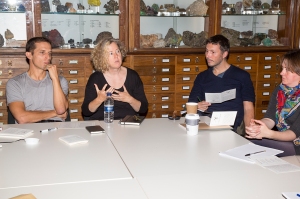RESPONSE #2 Sarah Longair
Our second meeting introduced us to a novel technique of engagement by participating in a formal process designed to sustain our attention on objects. The strategies of the Order of the Third Bird carefully created an environment in which we could immerse ourselves collectively in our silent investigations and study of things. From the name of the group itself and the design of the ‘order of service’-style card on which the process was described to the repetitive rhythm of Sal’s introduction, I was struck by the way in which analysis could be enhanced and transformed by the evocation of ritual.
Some elements of the four-part process were more effective than others for me – during the intense examination, I particularly enjoyed my imaginary walk through the cartography of the banknote design, as if it represented a landscape. Disengaging from the object after that was more of a struggle. I couldn’t help but observe the ways in which we were all moving and reacting to the objects, the space and each other, so hearing how everyone described their experience at the end was particularly illuminating. Rituals by their very nature are repeated – in this case the fixed structure of the process can be applied to different objects, groups and locations, which the members of the Order clearly find repeatedly offers new perspectives.
This session could not have been more different to my first opportunity to examine my objects closely. By arrangement I visited the Grant Museum out of public opening hours, so that the dodo bones could be removed from their case. The curator, Mark, was extremely patient in going through every single bone with me, explaining its function and whether any aspect of it was distinctive to the dodo. I scrawled notes, took photos and fired questions, gathering all the nuggets of information about dodo anatomy.
When carefully handling the bones, I was instantly struck by their weight. Some, particularly the tibias, are quite large, which provided these flightless birds with stocky strong legs. Yet, they were incredibly light. A shiny patina was visible on some parts of the bones – on closer examination of these discoloured, almost glazed, areas, we realised they often occurred where the joints met. Mark suggested this might have been where they had previously been adhered together, perhaps for display purposes. These traces shed light on previous attempts to understand and reconstruct these absent creatures.
George Clark was the collector who Mark suggested was the excavator of this set – a former schoolmaster in Mauritius who searched for years before excavating several subfossilised skeletons in the marshy Mare aux Songes region from 1865. These sets now reside in museums worldwide. The Grant Museum archives do not tell the full story, and between the different registers contain some intriguing inconsistencies but they also give evidence of an active museum network of exchange and acquisition. One challenge Mark has set me is to investigate these questions of provenance.
Now that I have satisfied my instinct to question everything, I will try to forget this context and attempt a 15-minute silent and sustained study at the start of each visit – a sort of one-person ‘Order of the Dodo’…

